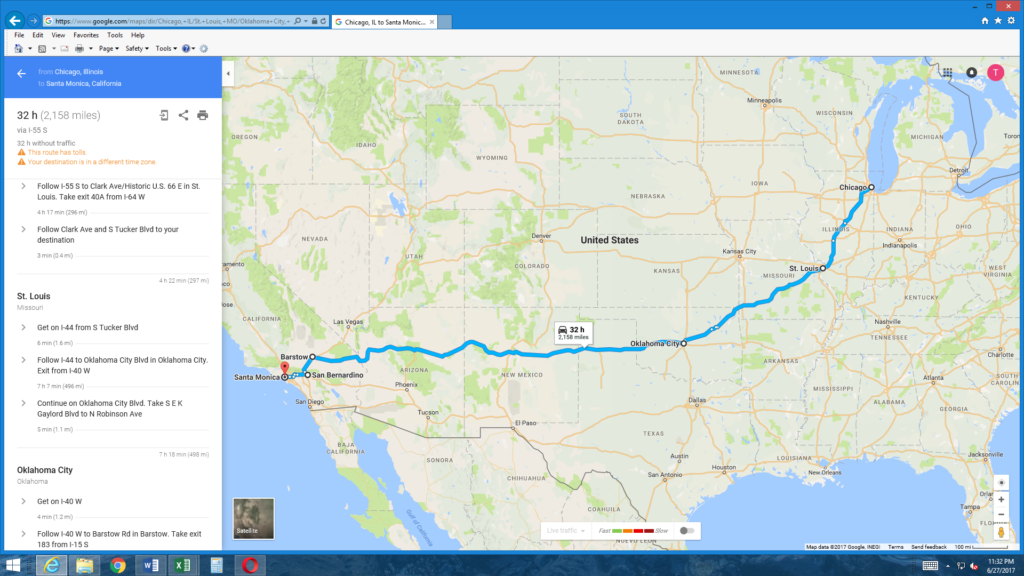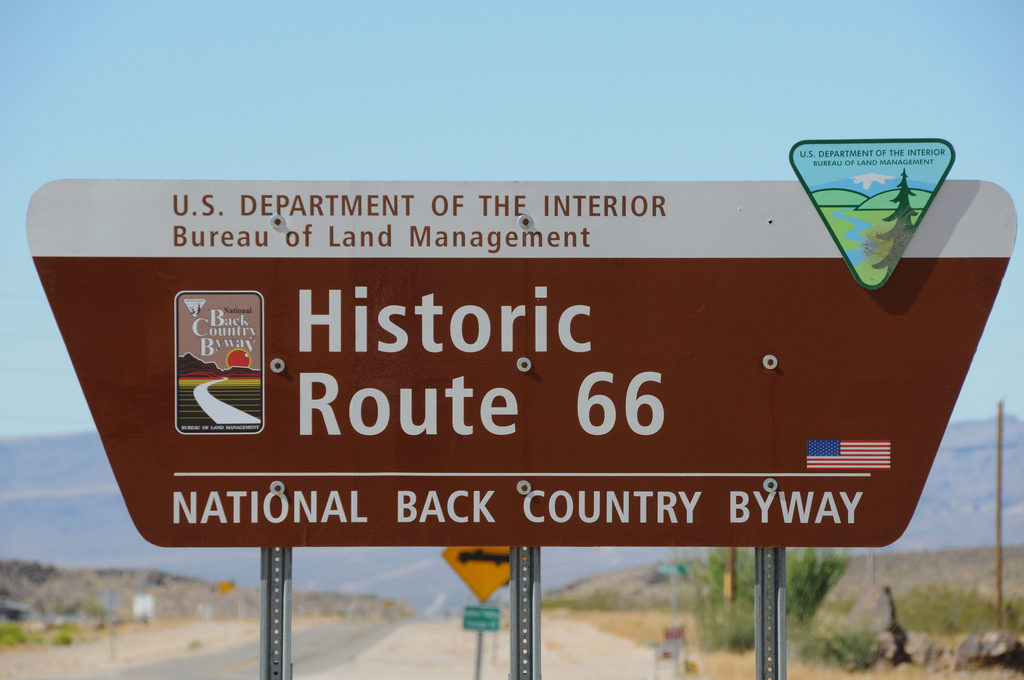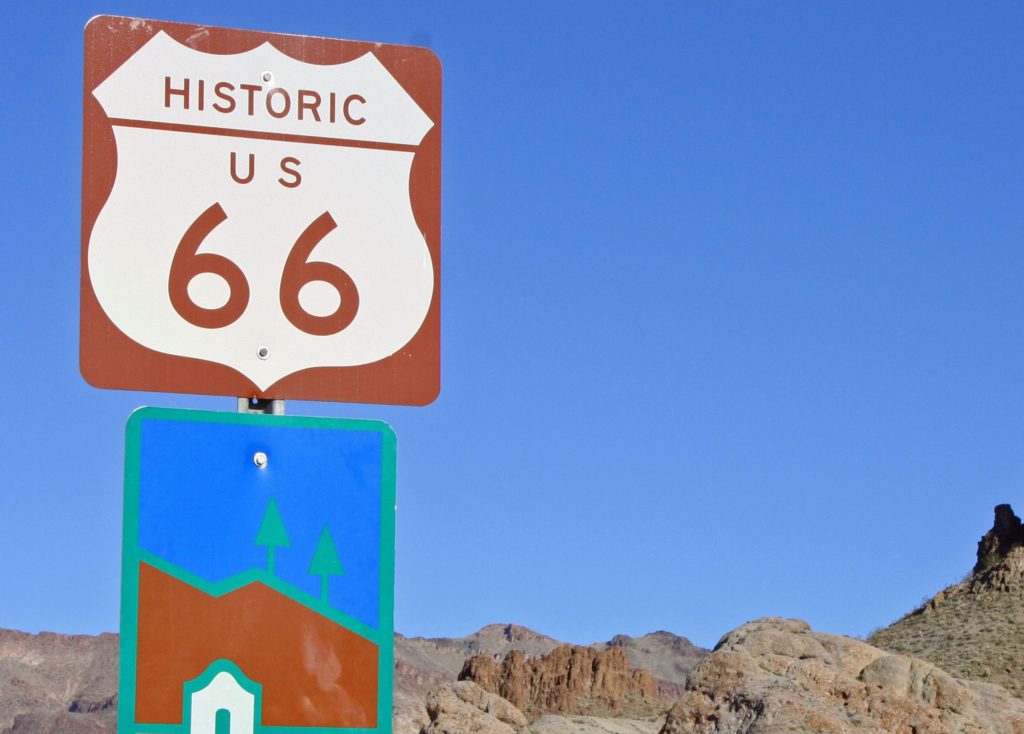Another day, it’s gonna be a long one.
CELEBRATED IN SONG:
ROMANTICIZED IN A 1960’S TELEVISION SERIES:
And, of course, immortalized by John Steinbeck who devoted an entire chapter (chapter 12) describing the Joad’s journey on this highway in The Grapes of Wrath:
“Cars limping along 66 like wounded things, panting and struggling.”
“People in flight along 66. And the concrete road shone like a mirror under the sun, and in the distance the heat made it seem that there were pools of water in the road.”
“Two hundred and fifty thousand people over the road, Fifty thousand old cars-wounded, steaming. Wrecks along the road, abandoned. Well, what happened to them? What happened to the folks in that car?”Â
But ultimately, he immortalized the road on the collective American psyche with a poetic phrase:
“66 is the mother road, the road of flight.“
Though she was born a long, long time ago.
U S Route 66 was completed on 11 November 1926. (The day had been declared Armistice Day in 1919. Congress passed a resolution calling for a national holiday in 1926 and it became the first Armistice Day in 1938. Later, in a 1954 declaration by President Dwight Eisenhower, it became Veteran’s Day.) Bobby Troup’s song takes some creative license with its geography. The original route of the highway actually stretched from Chicago to Santa Monica (but Santa Monica’s a lot harder to rhyme and it’s really close to L A. But while we can give him a pass on that some of the others are a little more questionable).
Although it was rerouted several times during its lifetime, the original U S Route 66 traversed eight states: 301 miles in Illinois, 317 in Missouri, a mere 13 miles in Kansas, 432 across Oklahoma, 186 in Texas, 487 miles through New Mexico, 401 in Arizona and finally 314 in California for a total of 2,448 miles.
I realize it was a bit of a stretch to connect President Eisenhower’s decision to rename Armistice Day to the completion of Route 66 but he has yet another oblique connection to the road. Route 66 was nearing its 30th anniversary when, with a stroke of his pen on 29 June 1956, the President approved the Federal Aid Highway Act of 1956 (popularly known as the National Interstate and Defense Highways Act). With that signature, Eisenhower began the process that nearly tolled the death knell for Route 66. (In one way, as we’ll see, it, in fact, did.)
In some ways, the model for the decline of 66 started in Oklahoma in 1953 with the construction of the Turner Turnpike – an 88-mile toll road between Tulsa and Oklahoma City that paralleled 66 but bypassed all the towns along the way. This was the first of a series of roads that would become Interstate 44 (I-44) and one of five interstate highways that would mirror the route of U S 66. Along other parts of the route, road improvements or rerouting sections of it were used to incorporate it into the interstate system subsuming those parts of Route 66.
Eventually, it would be I-55 from Chicago to Saint Louis, I-44 from Saint Louis to Oklahoma City, I- 40 to Barstow, California, I-15 to San Bernardino and I-210 to Santa Monica that would, step by step, replace Route 66. (In fact, the Interstate system has become so vast and pervasive that, in order to reproduce the route above, Google maps required inputting those step-by-step segments. If you simply ask it for directions from Chicago to Santa Monica, it opts to send you on I-80 across Iowa, Nebraska and so on.)
Across the southwest, rural sections of I-40 would be constructed first. Bypasses around cities would come later. As early as 1963, the small towns began feeling the economic stress of travelers whizzing by on the newly constructed superhighways. Under pressure from local business leaders, the state legislature in New Mexico enacted a law that banned the construction of interstate bypasses around cities if the local jurisdiction so requested it. Under the threat of the loss of federal highway funds, the same state legislature repealed the law by 1965.
The state of Missouri officially requested the designation “Interstate 66” for the Saint Louis to Oklahoma City section of the route, but it was denied. Piece by piece, Route 66 was decommissioned. The town that avoided the death knell the longest was Williams, Arizona but when the final section of I-40 was completed in 1984, the final stretch of the old highway was decommissioned. Perhaps because it had been sectionally amputated, a human Route 66 might have qualified for Social Security Disability but by dying at age 58, it would have never qualified for Medicare.
The process of decertification also meant that Route 66 began to disappear from road maps. When the highway was finally fully decommissioned, sections of the road were disposed of in various ways. Within many cities, the route became a “business loop” for the nearby interstate (usually surface streets that serve the downtown area). Some sections became state roads, local roads, or even private drives. Others were completely abandoned.
However, the fight wasn’t completely over. By designating them as state roads, some states managed to keep the 66 designation for parts of the highway. In Missouri, Routes 366, 266, and 66 are all original sections of the highway and, in Oklahoma, State Highway 66 remains as the alternate “free” route near its turnpikes.
In 1987, Angel Delgadillo, a barber from Seligman (pronounced suh-LEEG-muhn), organized a meeting of business owners who formed the Historic Route 66 Association of Arizona, the first of its kind. Similar groups arose in other states and, in 1990, Missouri declared its existing sections of US 66 a “State Historic Route”. The multi-state preservation drives culminated in 1999, when President Bill Clinton signed the National Route 66 Preservation Bill. That bill provided $10 million in matching fund grants for preserving and restoring the historic features along the route. And now, markers such as this one
or this one
designating the path of “Historic Route 66” dot the landscape.
Now that you have an idea of the life story of the “Mother Road”, it’s time for you to set off with me for a day trip along a stretch of Historic Route 66 through western Arizona.


